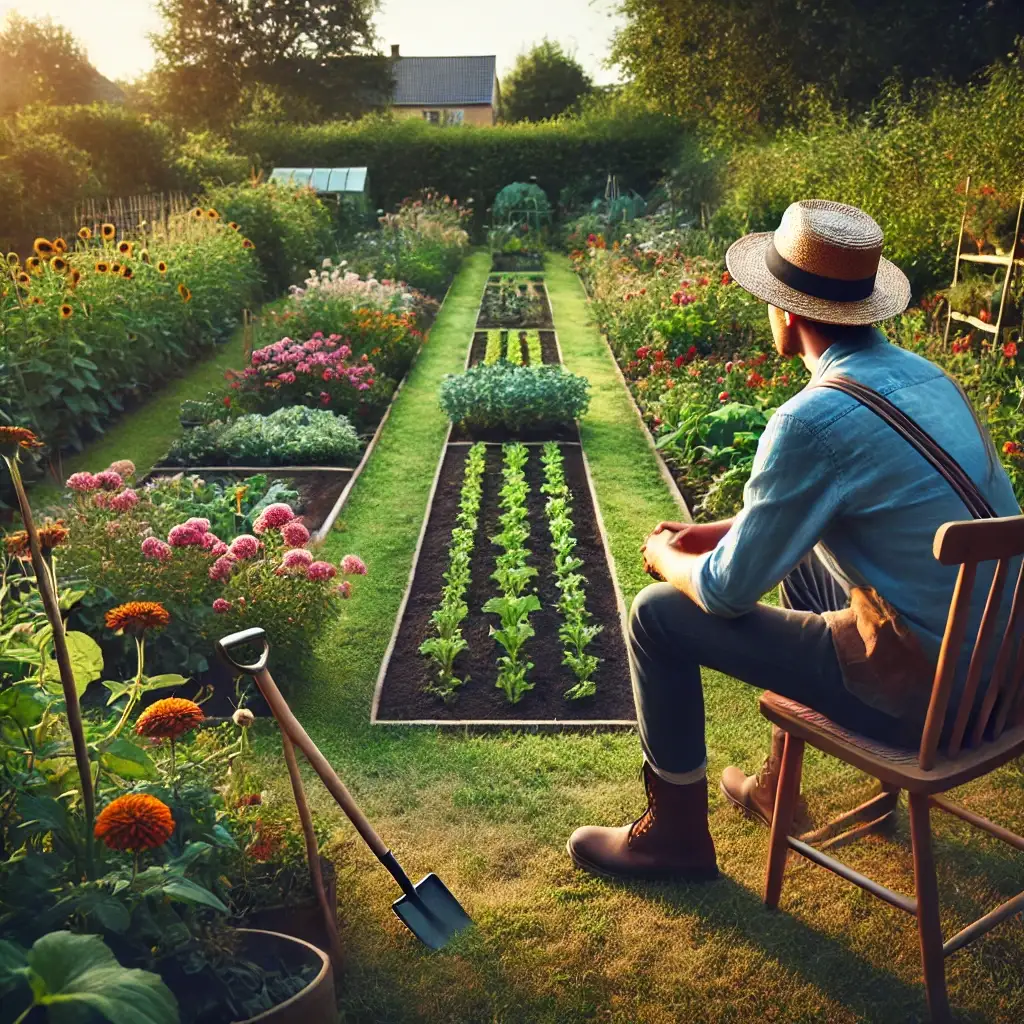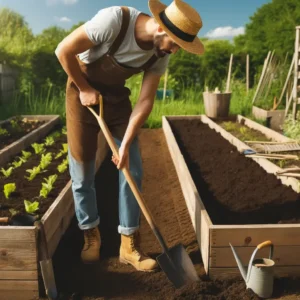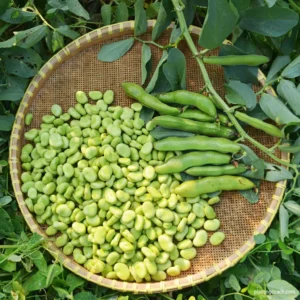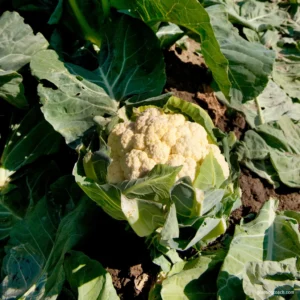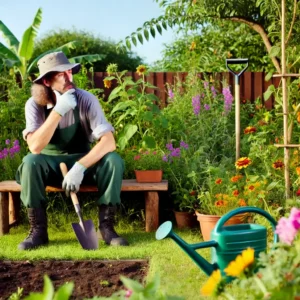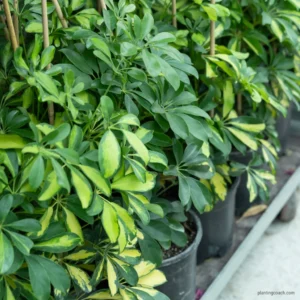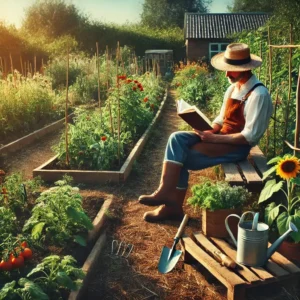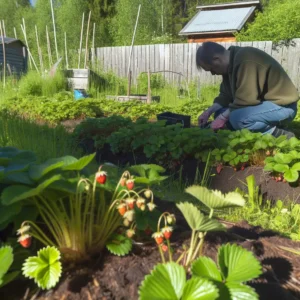Designing a perfect layout for your vegetable garden is an essential pre-requisite activity that brings numerous benefits- such as rewarding fresh produce, promoting physical and mental exercise, and bringing you closer to nature. A well-planned garden maximizes space efficiency, ensures healthy plant growth, and yields a satisfying harvest. Understanding garden design basics is crucial whether you are a beginner or an experienced gardener.
Whether you have a small balcony, a backyard, or a spacious plot, the principles outlined in this guide will help you design a garden that suits your needs and yields abundant rewards. This guide will walk you through essential tips and strategies about How to Design a Vegetable Garden, to help you create a perfectly productive and beautiful garden layout. From assessing your space to selecting suitable vegetables and implementing sustainable practices, these insights will set you on the path to gardening success.
Understanding Your Space
Assessing Your Garden Area
Before planting, assess your garden area to determine the best layout and plant placement. Measure your space to understand its dimensions and shape. Observe how much sunlight different areas receive throughout the day, as most vegetables need at least 6-8 hours of direct sunlight. Take note of shaded areas and existing structures like trees, fences, or buildings that might affect sunlight exposure.
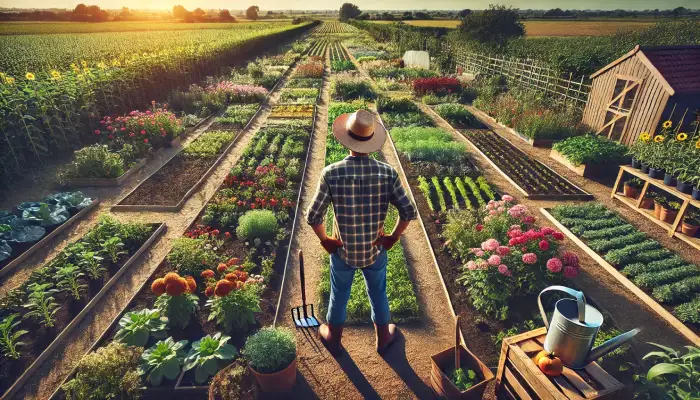
Additionally, wind patterns and access to water sources should be considered. This thorough assessment will help you choose the best spots for planting, ensuring your vegetables get the light, space, and nutrients they need to thrive. Proper planning can prevent future issues and maximize the productivity of your garden.
Soil Assessment
Soil quality is fundamental to successful gardening. Start by testing your soil to determine its pH and nutrient levels. Most vegetables prefer slightly acidic to neutral pH (6.0-7.0). Adjust the pH if necessary by adding lime to raise it or sulfur to lower it.
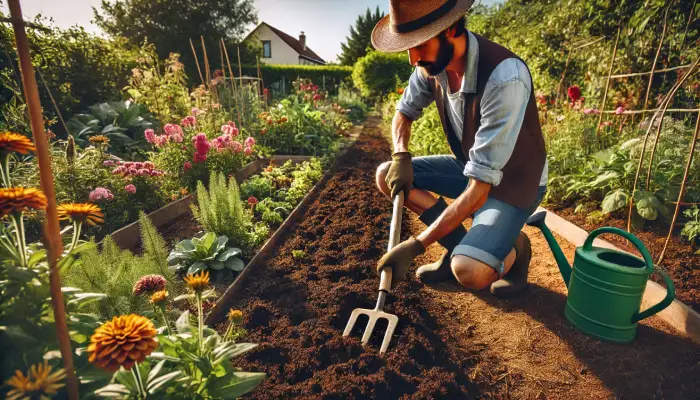
Check the soil texture—whether it’s sandy, loamy, or clay—as this affects drainage and root growth. Good drainage is crucial, so consider amending your soil with organic matter like compost to improve its structure and fertility. Adding compost enriches the soil with nutrients, improves water-holding capacity, and promotes healthy root development. Regular soil assessment and improvement will create an optimal environment for your vegetables.
Choosing the Right Layout
Traditional Row Planting
Traditional row planting involves growing vegetables in straight lines. This method is simple, making it easy to manage and harvest crops. However, it can be less space-efficient than other methods. To optimize row planting, ensure adequate spacing between plants according to their needs and align rows north to south to maximize sunlight exposure.
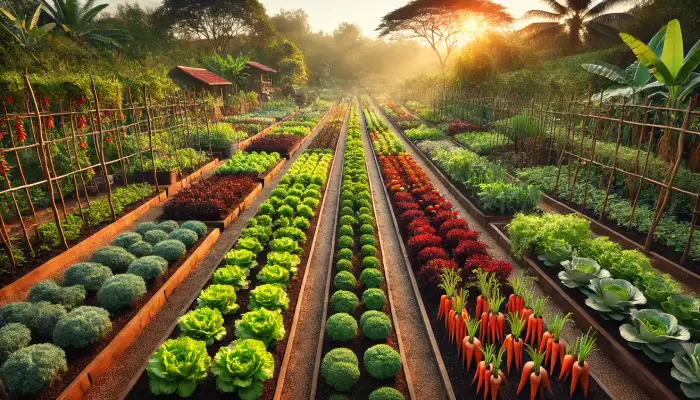
This layout is particularly suitable for large gardens and allows for easy use of tools like tillers and weeders. Rows make it straightforward to water, weed, and fertilize, helping maintain a tidy and organized garden. Traditional row planting remains a popular choice for its simplicity and effectiveness.
Raised Bed Gardening
Raised bed gardening is one of the most popular ways to create a modern gardening layout. It involves growing vegetables in soil elevated above ground level, usually enclosed by wooden or stone frames. Raised beds offer several benefits, including improved drainage, better soil quality control, and easier access to planting and harvesting.
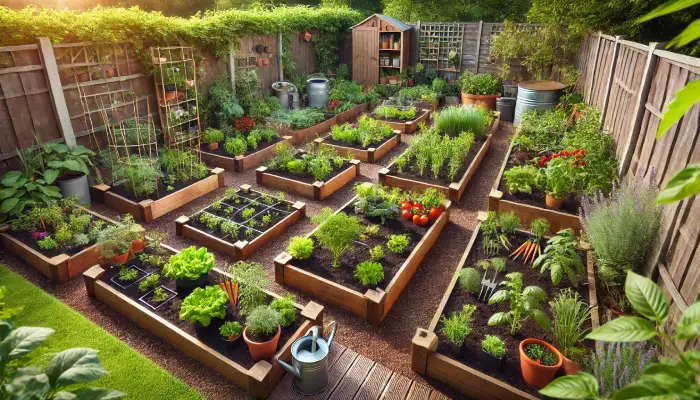
Building a raised bed is relatively simple: choose a sunny spot, construct a frame, and fill it with high-quality soil and compost. Raised beds can be particularly beneficial for areas with poor soil or limited space, as they allow for intensive planting and efficient use of space. They also reduce the risk of soil compaction and make it easier to manage weeds and pests.
Selecting Vegetables for Your Garden
Seasonal Planting Guide
Seasonal planting ensures that each crop grows in optimal conditions. Cool-season vegetables like lettuce, spinach, and radishes thrive in cooler temperatures and can be planted in early spring or fall. Warm-season vegetables such as tomatoes, peppers, and cucumbers require warmer soil and air temperatures and should be planted after the last frost date in your area.
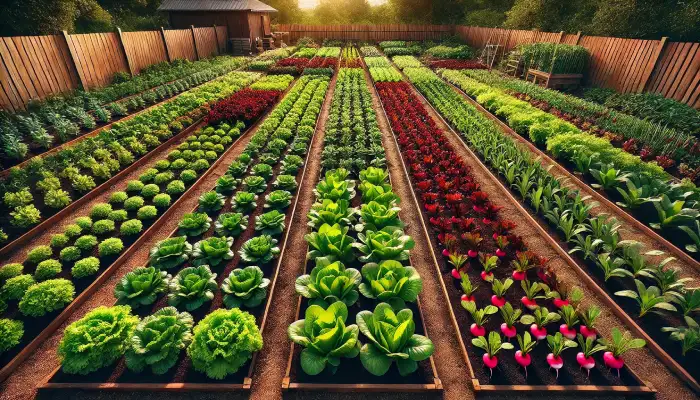
Creating a planting schedule based on seasonal variations helps you stagger planting times and harvests, ensuring a continuous supply of fresh produce throughout the growing season. Understanding the seasonal needs of different vegetables is vital to planning a productive and efficient garden.
Companion Planting
Companion planting involves growing different plants together to accelerate growth, deter pests, and improve soil health. For example, planting basil near tomatoes can increase their flavor and repel harmful insects. Marigolds are known to deter nematodes and other pests when planted among vegetables. Beans and peas can fix nitrogen in the soil, benefiting nitrogen-hungry plants like corn and lettuce.
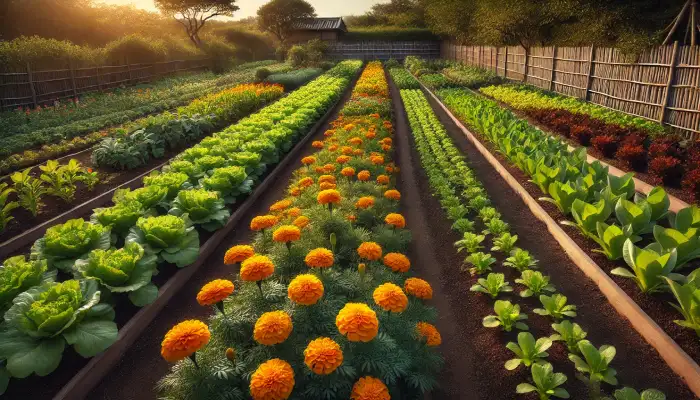
By strategically pairing plants, you can create a more resilient and productive garden ecosystem that reduces the need for chemical inputs. Companion planting can improve plant health and yield, making it an essential practice for organic and sustainable gardening.
Designing for Efficiency and Aesthetics
Pathways and Accessibility
Designing accessible pathways in your vegetable garden is essential for maintenance and harvesting. Ensure pathways are wide enough to accommodate a wheelbarrow or garden cart and choose durable materials like gravel, mulch, or stepping stones to create stable walking surfaces. Pathways make it easier to navigate your garden and help prevent soil compaction around your plants.

Plan your garden layout in such a way that you can comfortably reach all plants, reducing the risk of damaging them during maintenance. Well-designed pathways contribute to a more organized and efficient garden, making daily tasks easier and more enjoyable.
Incorporating Aesthetic Elements
A vegetable garden can be both functional and beautiful. Incorporate aesthetic elements like decorative borders, trellises, and garden art to beautify your garden’s visual appeal. Trellises and arbors add height and interest and support climbing plants like beans, peas, and cucumbers. Plant flowers and herbs alongside your vegetables to attract pollinators and beneficial insects, adding color and diversity to your garden.
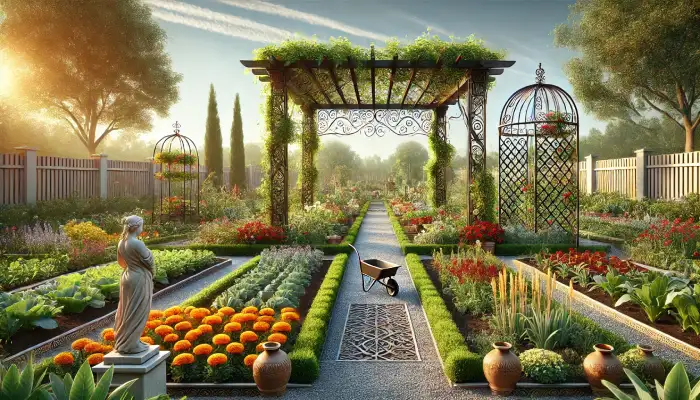
Balancing functionality with visual appeal makes your garden a pleasant space to spend time in and enjoy. Thoughtful design can transform your vegetable garden into a peaceful and inspiring retreat.
Implementing Sustainable Practices
Water Management
Efficient water management is crucial for a healthy vegetable garden. Install drip irrigation systems or soaker hoses to deliver water directly to the root zone, minimizing evaporation and runoff. Collect rainwater using barrels to reduce reliance on municipal water supplies and lower your water bill. Mulching around plants helps retain soil moisture, reduce weed growth, and regulate soil temperature.
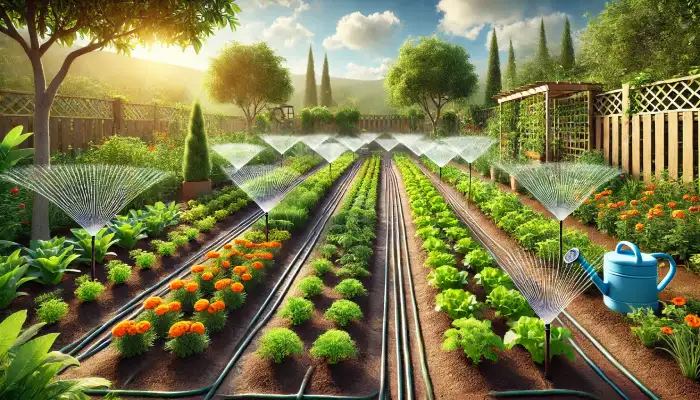
Water your garden early in the morning to reduce evaporation and allow plants to absorb moisture before the heat of the day. Sustainable water management practices ensure that your garden remains productive while conserving valuable resources.
Organic Gardening Practices
Embracing organic gardening practices benefits both your health and the environment. Use compost and organic fertilizers to enrich your soil and provide essential nutrients to your plants. Avoid synthetic pesticides and herbicides; opting for natural pests instead can control methods like neem oil, insecticidal soap, and companion planting. Encourage biodiversity in your garden by planting various flowers and crops that attract beneficial insects and promote a balanced ecosystem.
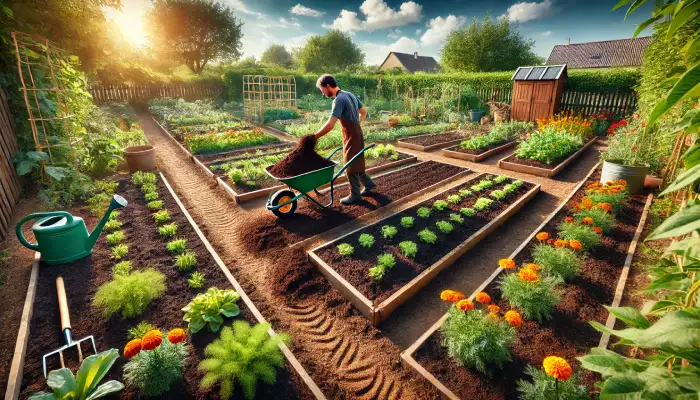
Organic gardening fosters a healthier garden and produces vegetables free from harmful chemicals, contributing to a sustainable and environmentally friendly approach to gardening.
Maintenance and Upkeep
Regular Garden Maintenance
Regular maintenance is key to a thriving vegetable garden. Tasks such as weeding, pruning, and mulching should be done consistently to keep your garden healthy. Weeding prevents competition for nutrients and water, while pruning helps manage plant size and encourages better airflow. Mulching conserves moisture, suppresses weeds, and adds organic matter to the soil as it decomposes. Creating a garden maintenance schedule can help you stay organized and ensure that essential tasks are completed on time. Consistent care and attention will keep your garden productive and looking its best throughout the growing season.
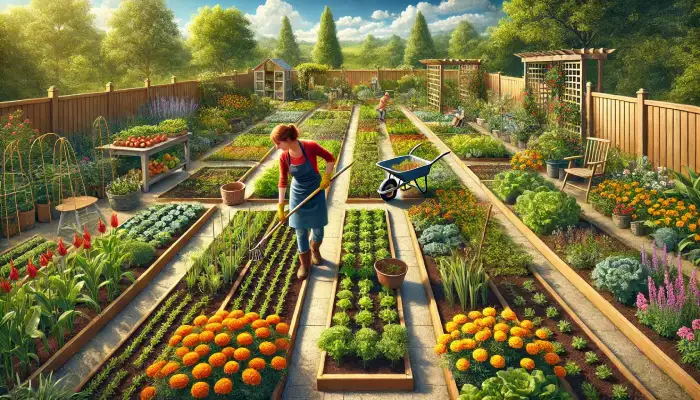
Monitoring Plant Health
Regularly monitoring the health of your plants allows you to catch and address problems early. Inspect your garden for signs of pests, diseases, and nutrient deficiencies. Common issues include yellowing leaves, spots, wilting, and stunted growth. Use organic solutions to treat problems, such as introducing beneficial insects to control pests or applying natural fungicides to combat diseases. Keeping detailed records of your garden’s progress can help you identify patterns and improve your gardening practices over time. Proactive monitoring and timely interventions will help ensure the long-term health and productivity of your vegetable garden.
Summary
Designing and maintaining a vegetable garden requires thoughtful planning and consistent care. You can create a productive and beautiful garden by understanding your space, choosing the right layout, selecting suitable vegetables, and implementing sustainable practices. Regular maintenance and monitoring ensure your plants remain healthy and yield abundant harvests. With these tips and dedication, you’ll enjoy the many rewards of a flourishing vegetable garden. Whether you are new to gardening or looking to refine your skills, these insights will help you achieve a successful and enjoyable gardening experience.
FAQ
Q1: How do I start designing my first vegetable garden?
Start by assessing your garden space, including sunlight, soil quality, and existing structures. Plan your layout based on the space available and the types of vegetables you want to grow. Consider raised beds or traditional row planting, and ensure good soil preparation.
Q2: What are the most important factors to consider in garden layout?
Consider sunlight exposure, soil quality, accessibility, and water management. Ensure your garden layout allows for easy maintenance and harvesting, with pathways wide enough for tools and equipment. Incorporate aesthetic elements to create a pleasant gardening environment.
Q3: Can I grow a vegetable garden in a small space?
Yes, you can grow a vegetable garden in small spaces using techniques like container gardening, vertical gardening, and square-foot gardening. Choose compact or dwarf varieties of vegetables and make the most of your available space by growing upward or using multi-functional containers.
Q4: How do I improve poor soil for my vegetable garden?
Improve poor soil by adding organic matter such as compost, aged manure, and green manure crops. Conduct a soil test to determine pH and nutrient levels and amend the soil accordingly. Regularly incorporating organic matter will improve soil fertility and structure over time.
Q5: What are some easy-to-grow vegetables for beginners?
Radishes, lettuce, tomatoes, zucchini, green beans, and carrots are easy-to-grow vegetables for beginners. They are hardy, require minimal care, and provide a rewarding harvest, making them ideal for new gardeners.
